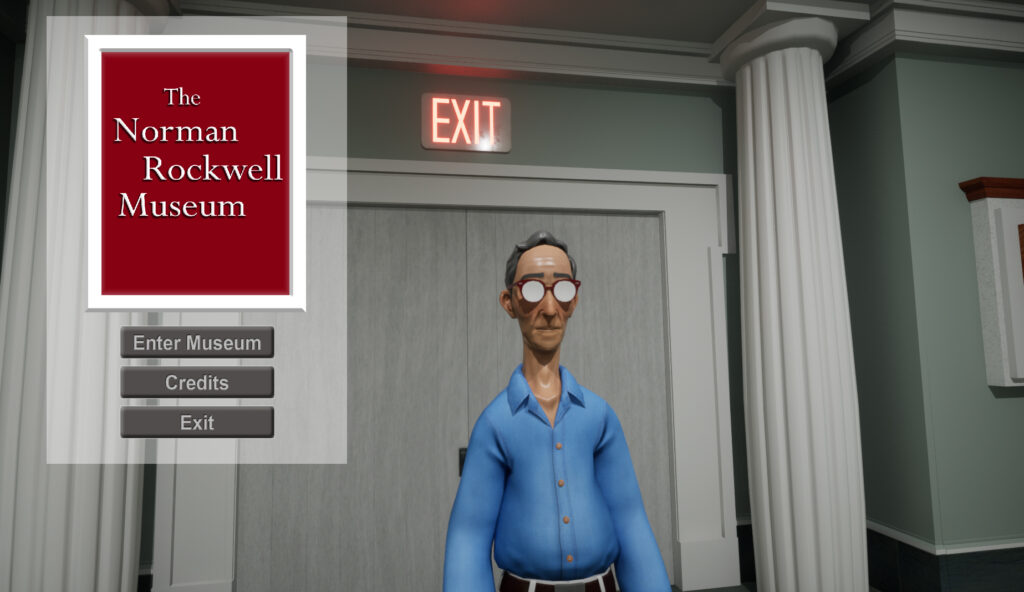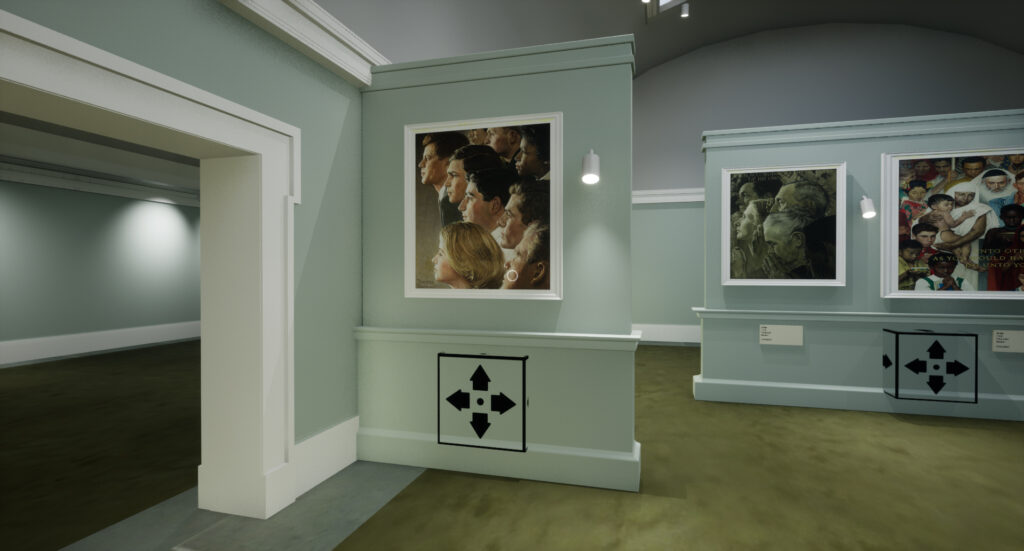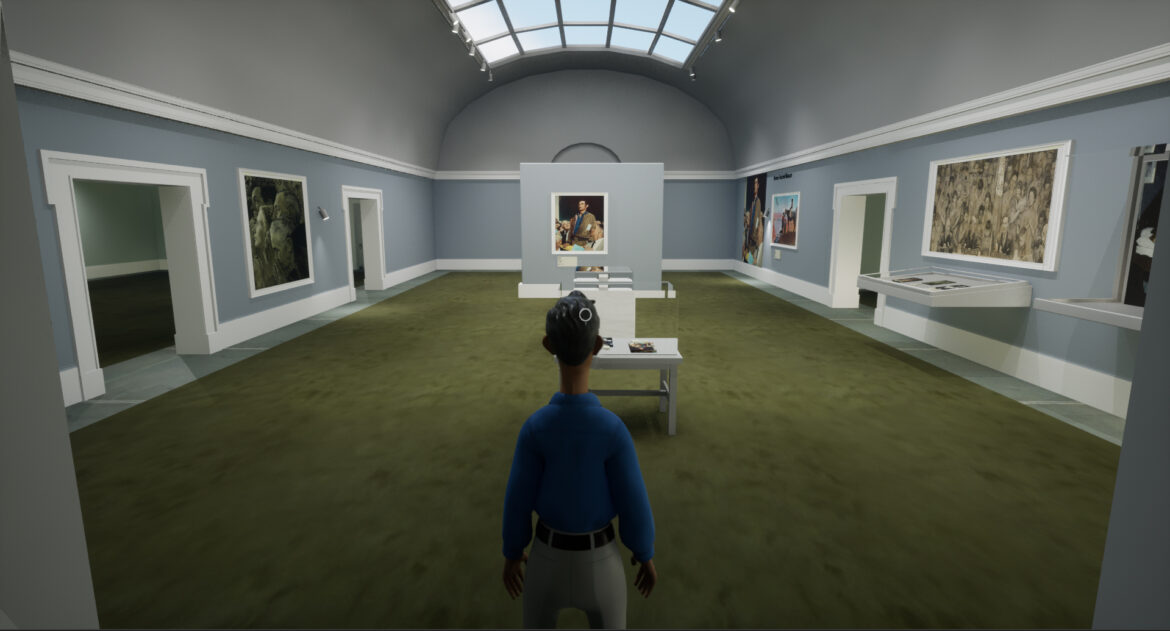By Isabella Cook
The technological advancements of the modern world can seem unreal at times, especially considering that only 30 years ago, having an at-home desktop computer was uncommon.
But now, almost everyone has a supercomputer tucked into their pocket or purse with the world at their very fingertips. And even as AI changes the landscape of art as we know it, new advancements are making just as much headway in changing the way we make, view, and access art.
Helping to harness this power of ever-evolving technology were students from Academy of Art University’s School of Game Development (GAM). After all, it is significantly easier to break the glass ceiling and achieve the impossible when one is not yet finished learning what is possible and what is simply not possible yet.
This dichotomy of possibility is apparent in the Academy’s most recent collaboration with the Norman Rockwell Museum, located in Stockbridge, Massachusetts, to create an entirely virtual exhibition utilizing the up-and-coming technology made available through Unreal Engine 5.

Unreal Engine 5 is a novel, open-source tool that can be used to create immersive 3D experiences; it is entirely free to use and the most advanced model of its kind, making it ideal for the Norman Rockwell project.
“Dare I say, people under the age of 40 probably don’t know who Norman Rockwell even is,” Norman Rockwell Museum Digital Innovation Officer Rich Bradway said of the famed American illustrator. “But the [Academy] students took all of their talent and creativity and great ideas of what we could be doing with the project, and it was infectious to see how inspired they became with the idea of… pushing the envelope of what we could do.”
The current collaboration between the Academy and the Norman Rockwell Museum is actually the fourth of its kind and is led by GAM Executive Director David Goodwine and GAM Technology Lead Phillip Kauffold. The first collaboration, however, began circa 2017 when Bradway reached out to the School of Illustration to ask for student talent to help with an exhibition traveling from the United States all the way to France.
“We had about 500 pieces of art and objects and what-have-you, and what we wanted to do was take all that artwork and make it entirely virtual,” explained Bradway. “So, we thought of the idea of making an interactive experience, kind of like the portraits from the Harry Potter series… and we wanted to work with Academy students to make designs, and the students’ work really brought those concepts to life.”
“We were going down the route of making a virtual museum guide with an avatar of Norman Rockwell and everything,” continued Bradway. “The idea was to use augmented reality glasses so you could walk in front of a Norman Rockwell painting, and an avatar of him would pop up and explain the piece, but then we realized no one wants to wear stuff in a museum.”

But Bradway did not let that small detail get in his way, and with a quick pivot and some inspiration drawn from a virtual panoramic program that effectively serves to simulate an immersive, 360-degree environment—this program is utilized primarily by realtors for virtual home tours and was a driving force behind the concept—an entirely virtual Norman Rockwell exhibition was created.
“Rich was like, ‘Hey, can we do this?’” said Goodwine. “So, we fleshed his idea out in 3D and took measurements and pictures of the entire museum. Then we gave that to Phil and his team, and they started building.”
“As it stands right now, it is not a VR project so much as an online exhibition and education tool to let people explore the museum and artwork,” added Kauffold.
The benefits of an entirely virtual tour are numerous, and globalizing the exhibition’s accessibility is only a small part of a much bigger picture. In fact, the virtual tour of the Norman Rockwell Museum offers more content than the in-person exhibition and has audio options available in six different languages that provide added context for each piece of art. The virtual exhibition also allows for interactions that can bring up reference photos and color swatches for the art in front of you, which is not a feature available at the museum’s physical location.
“Working with [the Norman Rockwell Museum] has done a lot of good for all of the students, especially working with and gaining knowledge from real-world experience,” said Goodwine. “Just being able to try things out that they weren’t sure were going to work or not, and solving problems because projects always have a few problems.”
Among the first group of students to work on the reboot of the Norman Rockwell Museum’s virtual exhibition was now Academy alum My-Linh Ha, whose role was to oversee the UI/UX functionality and to work alongside other students to create a professional product. Ha worked on the project alongside peer Spenser Myers.

“Spenser and I were signed on—basically hand-picked by Phil—to work on the [Norman Rockwell Museum] project,” explained Ha. “Spenser did a lot of work on the internal editor that we were building while I was making the interface to interact with said editor.”
After Ha and Myers graduated, a new group of students took over the work in progress. Among them was Michael Denhart, who later graduated in the spring of 2022. Denhart worked both as a team lead and helped streamline the exhibition’s saving system, the function that allows users to save their progress within the Unreal Engine 5 environment.
Denhart is excited to see how the project grows and develops as it continues to be passed down through the GAM student pipeline.
“I’m curious to see what they do this semester because it’s getting handed over again,” said Denhart. “I’m hoping I can continue seeing how it goes either way since it’s honestly one of those projects that a lot of people have been saying can’t be done. And we did it.”
“When you look at this kind of collaboration, the instructors are more like executive producers in our areas, making sure things are getting done,” shared Goodwine. “But the students, they are the ones really leading the show.”
